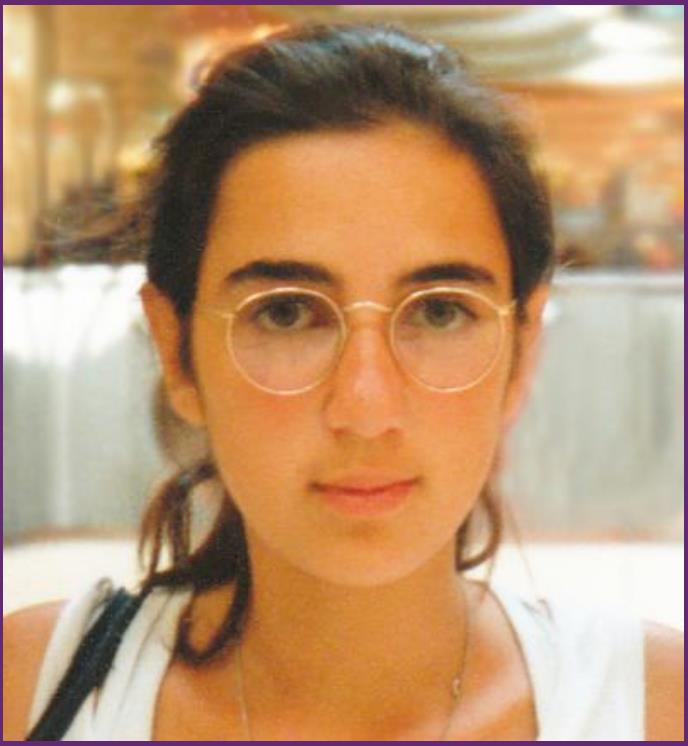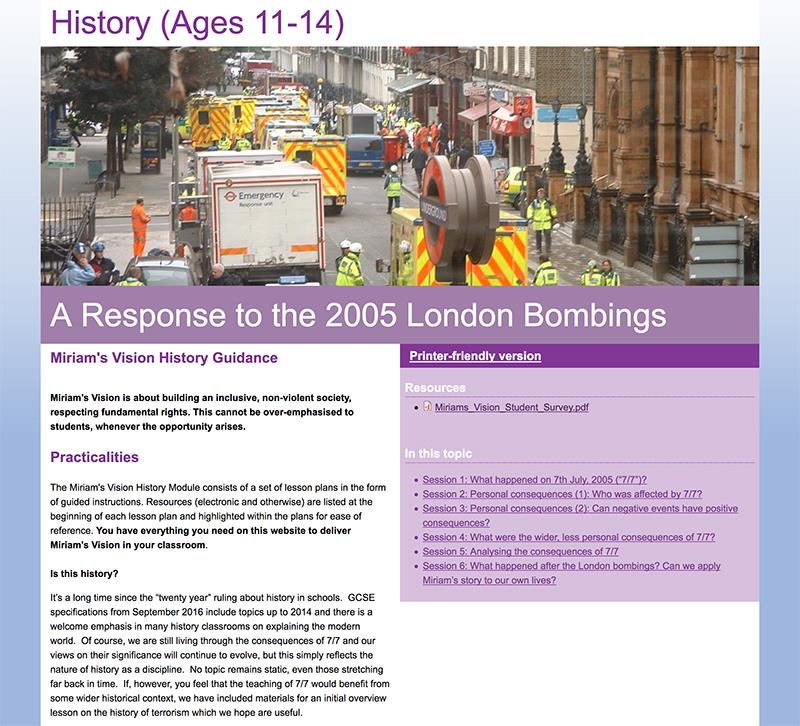On the morning of July 7, 2005, four terrorist attacks were carried out on the London transport system when 52 people were killed, hundreds injured and countless more traumatised.
Miriam Hyman was 32-years-old when she lost her life in the bus bombing in Tavistock Square.
For family, friends and community this was hugely painful. But it was avoidable and Miriam’s family resolved to respond positively by setting up the Miriam Hyman Memorial Trust.
A children’s eye care department in one of the best eye hospitals in India is her memorial and an education resource, Miriam’s Vision, is her legacy.
Written by teachers for teachers, Miriam’s Vision is a-political and secular. The cost-free resource, developed in association with the UCL Institute of Education (and with Copthall School, London, which Miriam attended), promotes a more inclusive society, safer from all forms of violent extremism.

This is irrespective of the way violence is expressed: in race hatred, knife crime, or any form of negativity.
In the words of one student: “This is not about statistics. It’s personal so you remember it more.”
Miriam’s Vision uses the personal story of Miriam Hyman – told in a series of short films – to frame series of lessons in six subjects. Some subjects use the events of 7/7 as a starting point, others draw on Miriam’s Indian heritage to explore cultural diversity and conflict resolution.
All explore an aspect of Miriam’s Vision from a particular angle – such as Different Needs: Common Ground, Different Backgrounds: Common Ground – and all are underpinned by subject knowledge and pedagogy. There are five key messages on life-skills across the six subjects:
- We can deal positively with adversity.
- We can balance risk with benefit.
- We can problem-solve within a democratic framework in real-world situations.
- We can embrace diversity.
- We can empathise and learn through the experience of others.
Miriam’s Vision is about replacing fear with understanding, encouraging a strong sense of self-worth and a constructive mind-set achieved through guided research, the use of examples from 7/7, and by open discussion in the safe environment of the classroom.
The lessons progress from knowledge and understanding to rational action through powerful narratives, supporting resources, dialogue, activities and opportunities for reflection. Students are required to work collaboratively and encouraged to apply the messages of the resources to their own lives. This was a particularly successful aspect in the pilot schools.
An evaluation and impact study funded by the government concluded that both teachers and learners found the programme engaging, inspirational and personally valuable in developing social and emotional skills and promoting mental health. This was made possible through positive narratives which show how it is possible to progress from knee-jerk reaction to reasoned response through non-violent means and within a democratic framework.
One teacher told us: “There’s no lecturing, no blaming, no dramatisation, so there’s more engagement and willingness to explore, question and discuss.”
The programme has three strands:
- History, citizenship and PSHE.
- Geography, art and dance.
- Business and enterprise.
Within these, two subjects address 7/7 directly – PSHE and history.

The PSHE sequence of lessons explores how we can respond positively to events like 7/7 in our own lives and consider the elements of risk-taking in learners’ own lives.
One student said: “We learned a lot that we wouldn’t in normal lessons, like the massive effect on people’s lives ... we need to value people, empathise, (and be) able to talk about it and deal with it.”
The history lessons focus on the evidence-based consequences of 7/7. While there are realities of that day which are negative, there are also positive outcomes and the broader underlying message is optimistic. In another student’s words: “Out of something bad, people came together to do good ... it’s inspirational.”
There are opportunities for discriminate listening, independent and critical-thinking, effective communication, and efficient team-work, all resulting in rational action.
Miriam’s Vision deals sensitively with loss, violence and negativity by showing resilience in extremity, positive response to negativity, and the importance of peaceful co-existence through democratic processes.
Teaching sensitive subjects is not necessarily part of teacher training, which is why the lessons are best delivered by teachers known to, and trusted by, learners.
In geography and citizenship, the focus is on human rights and conflict resolution, using Miriam’s story and her Indian heritage to provide case studies.
In citizenship, ways of bringing about change are explored through democratic means, using the example of building a third runway at Heathrow Airport.
In geography, an in-depth focus on the impact of mining on a local community and the environment in rural India provides insights into conflicting interests and conflict resolution.
One teacher said: “The resource shows coping mechanisms and ways to be positive about difficult, negative situations.”
The art and dance modules explore the theme of “different backgrounds, common ground” by hands-on experience of the craft and dance of India. Pipili appliqué lanterns, an ancient local craft, and a short Indian dance routine, provide contexts to explore the idea that all cultures express themselves through art and dance and the diversity of this expression is something to celebrate and appreciate.
An essential message is that “people from different And backgrounds have similarities as well as differences”.
Miriam’s Vision promotes responsible adulthood by creative thinking and constructive action at times of crisis.
A challenge to terrorist ideologies is central to government thinking and responsibility and the work of the Prevent Duty agenda is important. However, Miriam’s Vision builds on Prevent by understanding the factors which bind us such as our common need for shelter, sustenance and spirituality.
Teachers and learners realise that fear can be overcome by understanding, that there are constant opportunities for making positive choices, that actions have consequences for individuals who make them and for others.
One teacher said: “Official policy is about students who are already radicalised … what they hear from (Miriam’s Vision) is how to prevent it. It made the students grow up a bit.”
The resource has been well-received by teachers and learners, some of whom were grieving for the loss of a parent or who witnessed the bombing of the Manchester Arena on May 22, 2017. One teenager had a connection with a family directly involved in a recent attack in London. The question is: can Miriam’s Vision help young learners to deal positively with adversity and diversity, exercise empathy and contribute towards building a genuinely more inclusive society safer from violent extremism? Our impact evaluation study suggests that it can.
- Mavis Hyman is chair of trustees at the Miriam Hyman Memorial Trust. Email her at info@miriam-hyman.com. Alison Kitson is a senior lecturer in education at the UCL Institute of Education.
